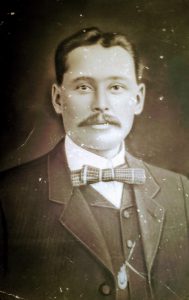
Recently, I was prompted to take a ‘second look’ at my wife’s grandfather, Horace Fenton Bloodgood. Fenton married my wife’s grandmother, a young Spanish girl named Magdalena Murrieta,[1] in Buena Vista, Sonora, Mexico, in 1908 while working for the railroad.[2] (He was 41 and she 16.) Family lore was that the senior Bloodgoods were so outraged by Fenton’s errant disrespect of the status quo that he had already been largely disowned prior to his parents’ deaths and his marriage to Magdalena. Indeed, Fenton was left only the proverbial $1.00 in the will of his father Julius Bloodgood.
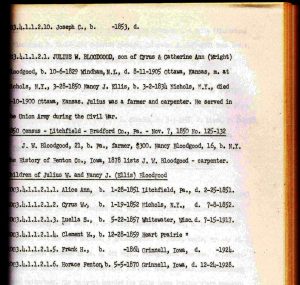
Fenton’s siblings, the children of Julius and Nancy Ellis Bloodgood, are named in The Bloodgood Genealogy, a book tracing my wife’s ancestry back to a robust Dutch sea captain, one Frans Janse Bloetgoet.[3] Six children are named in this family, with four children – Luella, Clement, Frank, and Fenton – surviving into adulthood. Three of the four children are recorded as having issue and original records substantiate the author’s work.
As I had researched this family I remained perplexed by the name of “Frank H. Bloodgood” on the list of Julius’s children.” The Bloodgood Genealogy indicates that Frank Bloodgood, son of Julius, married “Della Blackstone” (and had a son named Claude); however, I could find no records linking “Frank” to his father Julius. Further, “Frank Bloodgood” never appeared in any census records for the household of Julius Bloodgood. I could verify Frank’s Colorado marriage to Della but nothing more.[4] For years I believed that author must have placed “Frank H.” in the wrong family.
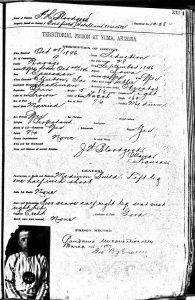 Recently, an unknown prison record for Fenton Bloodgood ‘escaped,’ sending my research (and conclusions) in a new direction.[5] Shown on this record as “F.H. Bloodgood,” Fenton was incarcerated for the crime of “Seduction.”[6] The prison record clearly identifies him (down to a very un-Casanova-like photo), naming his next of kin (J.W. Bloodgood of Ottawa, Kansas), his railroad occupation, and the fact that he is married. However, the year is 1896 – twelve years before he would marry Magdalena Murrieta.
Recently, an unknown prison record for Fenton Bloodgood ‘escaped,’ sending my research (and conclusions) in a new direction.[5] Shown on this record as “F.H. Bloodgood,” Fenton was incarcerated for the crime of “Seduction.”[6] The prison record clearly identifies him (down to a very un-Casanova-like photo), naming his next of kin (J.W. Bloodgood of Ottawa, Kansas), his railroad occupation, and the fact that he is married. However, the year is 1896 – twelve years before he would marry Magdalena Murrieta.
Married? There are no family records of any earlier marriages for Fenton. So who was this mystery woman? I hadn’t a clue. (I seem to be running into a lot of spouses no one ever wanted to mention lately.) I decided to research in the Facebook of those days – that is, early twentieth-century newspapers – to see what I could find. Had Fenton Bloodgood failed to update his relationship status?
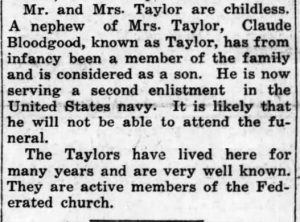
Almost immediately, I located news of a Mrs. Della Bloodgood and her son Claude. The newspapers reported that young Claude Bloodgood is ill with diphtheria and his mother Della is coming from Colorado to visit her son.[7] A son who is also a nephew, staying at the home of his (childless) aunt Luella Bloodgood Taylor – Fenton’s sister.[8]
Is this “Della” the wife of the same Frank H. Bloodgood who doesn’t seem to quite fit into the published Bloodgood Genealogy? Is Della the wife of the same “Frank” who doesn’t appear in census records for the family of Julius Bloodgood? Fenton’s sister Luella Bloodgood had no children. His brother Clement had only one son – a boy named Paul. If Fenton’s known children won’t be born for another twelve years, then who is the father of this nephew Claude? Who is Frank Bloodgood?
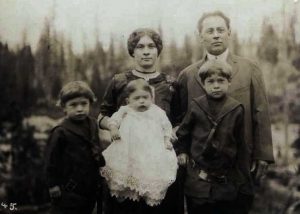
I remembered a baptismal record (almost ignored!) for Fenton’s son, my father-in-law Leroy Sterling Bloodgood.[9] Leroy’s parents were shown as “Frank H. and Magdalena M. Bloodgood.” The baptismal record was also consistent with a recently discovered marriage record for Fenton and Magdalena referring to him as Francisco Bloodgood.[10] Could there have been two Frank Bloodgoods in the same family? (Or had Fenton Bloodgood created a fake profile page?)
In the end I was able to determine that Fenton and Frank were the same person by comparing documents where Frank was or wasn’t named against the same for Fenton. From there I cross matched where either of them appeared in relation to what was written in the newspapers about “their” first wife Della (and son Claude), along with the later marriage record of “Frank” to Magdalena Murrieta. With the aid of the prison record I could see that a previously unknown marriage did exist for “F.H. Bloodgood.” With this I concluded that Frank and Fenton had to necessarily be the same man and that, in the end, there was only one “F.H. Bloodgood.”
I have always been interested in learning about the Bloodgood family, and even more so about the life of my wife’s grandfather. I was fortunate in being prompted by Ancestry.com to look at a prison record – a record I did not expect to contain any inherent vital records. I am pleased to be able to put to rest the mystery behind both Fenton’s identity and his past as I come to understand more of the circumstances behind the life he led.
Notes
[1] Magdalena (Murrieta) (Bloodgood) Hulteen, born at Barcelona, Spain 21 July 1892 and died at Cusick, Pend Oreille County, Washington 11 September 1944.
[2] Marriage of Fenton H. Bloodgood: the date of 25 March 1908 is provided by his daughter-in-law Doris Rydbom Bloodgood (1916–2008) as transcribed from old family Bible records.
[3] George M. Bloodgood, The Bloodgood Genealogy: Ancestors and descendants of Captain Frans Janse Bloetgoet, 1462-1963, 2 vols., 2 : 110. Filmed by the Genealogical Society of Utah, 1971.
[4] Colorado, County Marriages and State Indexes, 1862–2006, Ancestry.com, for the marriage of Frank Bloodgood to Della Blackstone (1864–1944) at Colorado Springs, Colorado, on 5 May 1891.
[5] Arizona, Prison Records, 1875–1929, Ancestry.com, for “F.H. Bloodgood,” resident, 28 October 1896, Yuma, Arizona, Yuma Prison: List of Convicts, Register and Descriptive.
[6] Arizona, Arizona Legislative Assembly, Laws of the Territory of Arizona: twelfth Legislative Assembly: also, memorials and resolutions, Arizona Miner, 1883, 11, AN ACT: To Punish Seduction: “Any person who under promise of marriage shall have illicit carnal intercourse with any female of good repute for chastity, under the age of twenty-one years shall be deemed guilty of seduction…”
[7] The Ottawa Daily Republic, Ottawa, Kansas, Monday, 15 March 1897, 3. Newspapers.com
[8] The Ottawa Herald, Tuesday, 24 July 1917, 1. Newspapers.com: Luella Bloodgood Taylor (1857–1917), wife of Orlando Lindley Taylor (1856–1945).
[9] Leroy Sterling Bloodgood (1909–1994).
[10] Buena Vista, Sonora Mexico marriage records, 25 March 1908, [translated] “present the gentleman Francisco Bloodgood and the young lady Magdalena Murrieta with license to celebrate the marriage they have initiated…”
Wow Jeff, that was one of the most interesting genealogical articles I ever read. Thank you for sharing this
The family secrets being uncovered via the internet and diligent researchers continue to amaze me. Thanks for sharing this interesting story.
Interesting story! Sometimes you just never know what to expect. Say, can anyone tell me exactly what it meant to leave $1 to a child? I recently found such a will where my 3rd g-gf left $1 each to the three children of his first marriage (he was married twice – children with both).
Very simply stated, in the old days, if you didn’t do something to remember the children in your will, the courts would interpret that to mean that you forgot to put them in the will, and they would get an automatic pro rata share of the estate if they challenged it. Giving them $1 each was cheaper then having them get a bigger share of the entire estate. It varied from state to state, but most states have eliminated that provision.
Thank you for the answer :-).
Hi Janice, good question! – My guess is that there may be multiple correct answers depending on the times the person lived in and the jurisdication. As near as I can tell, leaving $1 is (or was) a way to possibly avoid a challenge to the will and also about acknowledging that a particular a person was intentionally left out. That being said Janice, I am hardly an attorney from the present or the past – but as also evidenced by your experience it looks to have been a pretty common practice “back in the day.” Many thanks for this!
Thank you Jeff! 🙂
A few years ago a childless aunt died in Georgia. All of her nieces and nephews were sent a letter about her will which stated that she was leaving her estate to the nephew who helped her with everything most of her life and not leaving anything to any other relatives. It was in legalese but basically was the same as leaving a dollar to family not inheriting anything.
This is a great bit of detective work. My wife is a Bloodgood and just yesterday I was working on this branch of the Bloodgoods as they are also related to our adopted daughter. I also came to the conclusion that Fenton was Frank. So this morning when I continued my research to see if I could find any supporting information, your story was first item that popped up on a Google search.
Hello!
I am curious as to your opinion of the two George Bloodgood books. I am the son of Jane Gray Bloodgood and am currently plowing through Volume I, which is where I make a (brief) appearance. I have copies of both the 1963 version and the 1980 revision of that work, and am finding a disturbing number of errors, not all of which can be attributed to the recent improved access to genealogical material on the internet (there are documents which he definitely had access to that he appears to have ignored). There is an entire Bloodgood line that he has located in North Carolina, which is connected to Frans Janse by such a tenuous thread that I fear that they are not related to him at all.
George also seems to shy away from anything remotely negative about the family, which may explain the lack of research on the Frank/Fenton connection you discovered. For example, the suicide of Helen Ashton Bloodgood in 1910 is omitted and he posits that the lack of a mention of children in her father William’s 1929 NY Times obituary suggests he was childless (although Helen appears alongside WIlliam in two censuses identified as his daughter). Similarly, he describes John Bloodgood as “a man of considerable importance”, without mentioning the fact that within a week of his 1928 death, it was revealed in the same papers that carried his obituary that he had embezzled north of $2,000,000 from the estate of his father-in-law, William Lottimer (not “Lattimer”, as George spells it when referencing John’s marriage) of which he was a trustee.
Again, I am curious to see what you think.
Jim Bigwood
Hi Jim!
Many thanks for your note. As I am only a “Bloodgood by marriage” I have to admit that I am far from an expert on my wife’s family, though for obvious reasons the Bloogoods have always been one of my favorites in attempting to follow. I have not seen the 1963 version, only the 1980 version, and like you I have found errors – some very close to home as you can see from the above post. That being said, in my extremely unqualified opinion – it hasn’t been a bad guide book for where we can “start to look” at The Bloogoods. I think of not having any compilation of the Bloodgood family at all and how difficult it would have been for me to discover the error that Frank and Fenton (above) were the same man – I would have had no starting point – I wouldn’t have even known that there was an error that needed to be addressed. Yes, it could be argued that the Bloodgood Genealogy helped to create the error, but I have to believe the error would have occurred anyway. So in this regard I am grateful to George Bloodgood for putting it all together, right or wrong, he gave me a jumping off point.
Ah, yes, old “Handsome Jack” John Bloodgood and the Lottimer fortune, and poor Clara his tragic wife. I’m with you on this in that I wish he’d said more about them both, if only because they are wonderfully colorful characters that are so enjoyable to learn about. I like to think that he omitted much about Handsome Jack (referring to him only as of “considerable importance”) to save on space in the tome – as even by 1963 any scandal surely would have already died down. The author certainly lost out in the telling of this tale though!
The issue with Helen Ashton Bloogood’s death may be due to the sensitive nature of her death and the custom of the times (1960-1980) regarding talking (or not talking about) about suicide. However, the failure of the author to connect her to her father William was extremely short sighted, and I agree, with census records available – negligent of him not to have given at least a cursory look. That being said, it was before before on-line records, and he may have simply run out of time.
I know I haven’t done much to assuage your issues with the book(s) and believe me I am not entirely defending it. However, I know that like me you’ve discovered that any published genealogy must be taken in with the caveat to reconfirm – but also enjoyed for the clues they give us!
As a side note – I see that in addition to being a cousin to my wife, you and I may share a common ancestry from Joseph Clarke and Bethia Hubbard as 8th cousins!
I really appreciated your note, and hope you will keep in touch.
Kind regards,
Jeff Record
jeff@therecordfamily.com